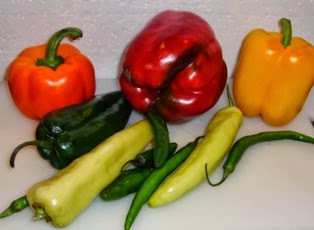How to Freeze Peppers
If you like frozen peppers in the winter, just imagine how good it would taste if you had picked a bag yourself and then quickly froze it at home! It is also one of the simplest ways to put up a vegetable for the winter. Here’s how to do it, complete instructions in easy steps and completely illustrated. The peppers will taste MUCH better than any canned or frozen you’ve ever had from a store. And if you’d rather can your peppers, see this page.
Directions for Freezing Peppers
Ingredients
- fresh peppers – any quantity (about one handful per serving)
Equipment
- 1 Large pot of boiling water
- 2 large bowls, one filled with cold water and ice.
- 1 sharp knife
- Vacuum food sealer or “ziploc” type freezer bags (the freezer bag version is heavier and protects better against freezer burn.
Instructions
Step 1 – Get your peppers!
Start with fresh peppers – as fresh as you can get. Select crisp, tender, green or bright peppers. If there is a delay between harvesting and freezing, put it in the refrigerator or put ice on it. And don’t use peppers that are old, limp, overripe or dried out (see below):
Step 2 – Wash the peppers!
I’m sure you can figure out how to rinse the peppers in plain cold or lukewarm water.
Step 3 – Slice the peppers in half, scoop out the seeds and cut into smaller pieces
Cut out stems, cut in half and remove seeds. If desired, cut into 1/2-inch strips or rings.
Of course, if your prefer Julianne cut peppers, you can cut the peppers lengthwise in thin strips instead or chop into smaller pieces.
Step 4 – Decide how you will be using them later
This determines how you will prepare them
- If you will be using them heated (in cooking):
- Then you will need to water blanch them – go on to Step 5
- If you will be using them in uncooked foods where you need a crisper texture, or possibly still use them in cooked foods:
- Skip to Step 7
Step 5 – Blanch the peppers
- Get the pots ready. Get the pot of boiling water ready (about 2/3 filled) and a LARGE bowl with ice and cold water.
All fruits and vegetables contain enzymes and bacteria that, over time, break down the destroy nutrients and change the color, flavor, and texture of food during frozen storage. peppers requires a brief heat treatment, called blanching, in boiling water or steam, to destroy the enzymes before freezing. Blanch the pepper halves for 3 minutes; and strips or rings for 2 minutes.
- Then cool them promptly in a large bowl of ice water for 3 or 4 minutes. Drain and package, leaving 1/2-inch headspace. Seal and freeze.
The duration is intended to be just long enough to stop the action of the enzymes and kill the bacteria.
Begin counting the blanching time as soon as you place the peppers in the boiling water. Cover the kettle and boil at a high temperature for the required length of time. You may use the same blanching water several times (up to 5). Be sure to add more hot water from the tap from time to time to keep the water level at the required height.
Step 6 – Cool the peppers
Cool peppers immediately in ice water. Drain the peppers thoroughly. After vegetables are blanched, cool them quickly to prevent overcooking. Plunge the peppers into a large quantity of ice-cold water (I keep adding more ice to it). A good rule of thumb: Cool for the same amount of time as the blanch step. For instance, if you blanch sweet peppers for 7 minutes, then cool in ice water for 7 minutes.
Drain thoroughly.
Step 7 – Bag the peppers
I love the FoodSavers vacuum sealing – these things really work. If you don’t have one, ziploc bags work, too, but it is hard to get as much air out of the bags. Remove the air to prevent drying and freezer burn. TIP: If you don’t own a vacuum food sealer to freeze foods, place food in a Ziploc bags, zip the top shut but leave enough space to insert the tip of a soda straw. When straw is in place, remove air by sucking the air out. To remove straw, press straw closed where inserted and finish pressing the bag closed as you remove straw.
Step 8 – Done!
Pop them into the freezer, on the “quick freeze” shelf, if you have one!
Tips:
- Harvest the peppers at its peak maturity but not old – mushy! Younger is better than older
- Process promptly after harvesting, or keep cooled in the fridge or with ice until then.
Frequently Asked Questions
How long can they be frozen?
It depends upon how cold is your freezer and how you packed them. Colder (deep freezes) are better than frost free compartments, which actually cycle above freezing (that’s how they melt the ice). Vacuum packing results in longer storage capability, too. Thicker bags also help prevent freezer burn.
In general, up to 9 months in a ziploc bag in an ordinary freezer, and 14 months in a deep freeze in a vacuum packed bag. After that, they peppers won’t make you sick; they just won’t taste a s good.

